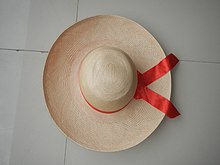

The buntal hat is a traditional lightweight straw hat from the Philippines made from very finely-woven fibers extracted from the petioles of buri palm leaves. It is traditionally worn by farmers working in the fields and was a major export of the Philippines in the first half of the 20th century. It can also be paired with semi-formal barong tagalog as well as informal attire. Its main centers of production are Baliwag, Bulacan, and (historically) Sariaya and Tayabas in Quezon Province. Buntal hats produced in Baliwag are also sometimes known as balibuntal hats (a portmanteau of "Baliwag" and "buntal"), and are regarded as superior in quality to other types of buntal hats.
Buntal hats were traditionally woven into wide-brimmed farmer's hats for the domestic market. Later versions of the hat using softened fibers and a finer weave are woven into a form resembling the fedora, and it is often mistaken for and sold as the very similar Panama hat or under the name Bangkok hat. These versions are characterized by being durable, yet light, and with a silkier texture than Panama hats. It can also be woven into other forms, including as women's braided wide-brimmed sun hats known as the baliwag hat (also named after the town of Baliwag).[1] Buntal hats are also sometimes known as the parabuntal hat (cf. parasisal), East Indian Panama hat, or Italian straw hat.[2]